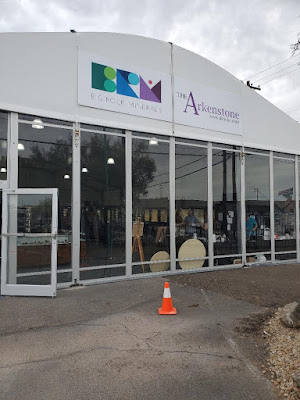As stated in other recent posts the Shows of Tucson seem to be moving north along Oracle Road, the major north-south path leading north from downtown. One of the new venues is The Mineral City Show centering around Oracle and Lester and anchored by a number of high-end dealers selling some very beautiful, and expensive, minerals (Collector’s Edge from Golden, Colorado, is an example). It was also the home of Joe Dorris and Pinacle 5 minerals from Colorado Springs (one of 4 or 5 Shows for Joe), and for Leonard Himes from Colorado Springs. The dealers (I count around 40) are spread out along a couple of streets and locating specific dealers is a confusing proposition, as is parking. I presume that logistics will be better next year.
 |
| Semi permanent, or so it seems,Tucson show home of the Arkenstone Fine Minerals operated by Rob Lavinsky. |
 |
| Calcite, fluorite and chalcopyrite collected Hardin County, Illinois priced at $450.. |
 |
| Fluorite collected August 26, 1019. Large right specimen priced at $12,500 but take home the left crystal for $10,000. |
 |
| Nice ferberite (iron tungstate) crystals from the Rock Currier Collection. |
Matrix India may have the largest building in the Show but I was unable to visit all of the widely scattered dealers.
 |
Always room for some amethyst.
|
 |
Maybe a froggie or two?
|
Trofast (see suggested reading below) noted that: “Sweden has a long tradition of mining and assaying. As early as the mid–17th century, Sweden had a chemical laboratory devoted to the study of minerals and ores and the art of mineral analysis. The resulting research was often used to improve mining, iron, and steel production. During the first decades of the 19th century, Jacob Berzelius’ laboratory in Stockholm became the center of these activities. From 1803 to 1843, Berzelius (1779–1848) and his Swedish pupils J.A. Arfvedson, N.G. Sefström, and C.G. Mosander discovered and characterized no less than 10 new elements. Many of these discoveries were made using a simple instrument—the blow pipe.
So, the great James Dwight Dana named the mineral berzelianite in Jöns’ honor. OK, who has heard of berzelianite? Not this ole softrocker. Maybe Yooper Pete up at the USGS? I saw a specimen of berzelianite in Tucson that was once in the collection of V.J. Hoffmann and decided it was coming home with me, mainly due to its composition, a copper selenide [Cu2Se]. Seems like that may be the only selenide mineral (selenium as the negative anion) in my collection.
Berzelianite is rare in the mineral record and was first described from the Skrikerum Mine located in south central Sweden; a mine “famous” for producing rare selenides. Besides berzelianite, the Mine is the Type Locality of three other rare copper-silver selenides: crookesite, eucairite, and selenojalpaite. The minerals are found in fracture-fillings hosted by vein calcite associated with hydrothermal alteration. Copper was first mined ~1779 and some exploration and mining, mostly for selenium, continued until the end of the 1800s.

 |
Two photos (BAD--see comments. Better photos later) of berzelianite veins in calcite. Better photos later. There also my be other selenide minerals present. Maximum width of lower specimen ~1.8 cm.
|
Berzelianite is a soft (~2.0-2.5 Mohs) metal with a
metallic luster, a lead-gray to blue gray to black color (but shiny when
fresh), an irregular fracture, and is opaque.
It occurs as microcrystals disseminated in a carbonate matrix (calcite
at the Type Locality). At times it
almost appears as a “stain” within the matrix and is difficult to distinguish
from other selenides.
REFERENCES
CITED AND SUGGESTED READING
“Undersökning
af en ny Mineral-kropp, funnen i de orenare sorterna af det vid Fahlun
tillverkade svaflet.” [Investigation of a new mineral body found in the impure
varieties of the sulfur produced at Fahlun---according to Google translate]
Published Online: 2011-09-01 | English
DOI: https://doi.org/10.1515/ci.2011.33.5.16
Chemistry v 33, issue 5

